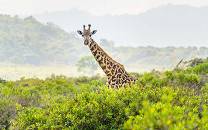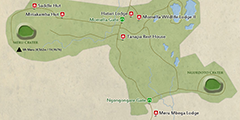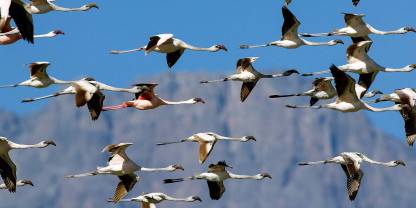Arusha National Park is dominated by Mt Meru (4,562m/14,967ft), Tanzania’s second-highest peak after Mt Kilimanjaro. The popular climb takes four days. A day hike to Meru Crater is less challenging, but very rewarding too. Wildlife viewing is rather low-key, but the varied landscapes, flocks of flamingos and superb forest birding make the park a great addition to a Northern circuit safari.

-
Best Time To Go
- June to October (Animals are easier to spot)
-
High Season
- July to March (The park can get busy)
-
Size
- 552km² / 213mi²
-
Altitude
-
1,700-4,562m /5,577-14,967ft
 View Photos
View Photos
 View Photos
+24
Photos
View Photos
+24
Photos
 Open Map
Open Map
Pros & Cons
- Very scenic with different habitats, including forest
- Views of Mt Kilimanjaro
- Excellent birding with about 400 species
- Close to Arusha and accessible for a day trip
- , mountain biking, walking and mountain climbs offered
- Some major safari animals aren't present or easily seen
- Small game-drive circuit
Wildlife
The Momela Lakes area is best for seeing buffalo, giraffe, defassa waterbuck and Kirk’s dik-dik. There is less general wildlife in the forest areas of the park but keep your eyes open for bushbuck and the beautiful, but very shy, Harvey’s red duiker. If you’re lucky you might see elephants too. The park’s flagship animal is the Kilimanjaro colobus, a type of monkey that only otherwise occurs on Mt Kilimanjaro and in two obscure forests in Kenya.
More about Arusha NP's wildlifeScenery
The most prominent landmark in Arusha is Mt Meru. Ngurdoto Crater is another highlight not to be missed. With its forested walls, the 400m-/1,300ft-deep extinct volcano is often described as a mini Ngorongoro. And no visit to the park is complete without a drive around the Momela Lakes. Flocks of flamingos usually make for some great photo opportunities, and on a clear day a backdrop of Mt Kilimanjaro completes the scene.
Activities
There are lots of exciting activities on offer aside from and . Climbing Mt Meru is an excellent way to acclimatize for Mt Kilimanjaro. You might even enjoy it more. Tanzania’s second-highest mountain is blissfully uncrowded and you’re likely to see some wildlife along the way. Other activities include on the Momela Lakes, guided mountain biking and a scenic half-day hike into Meru Crater.
Weather & Climate
Arusha National Park has a mild climate with average daytime temperatures ranging from 18°C/64°F to 23°C/73°F. The Dry season (June to October) is the coldest time of year. If you’re doing an early morning game drive, you’ll need plenty of warm clothes. The Wet season (November to May) has two periods of rainfall with a dry spell in between. But it’s only during the so-called long rains (March to May) that downpours might hamper your safari.
More about the weather and climateBest Time To Visit
Wildlife viewing is at its best in the drier months (June to October). At this time, days are usually sunny, but it can be bitterly cold early in the morning and late afternoon. Birding is generally best in the Wet season months of November to April.
More about the best time to visit



